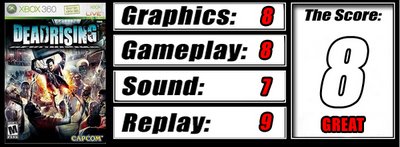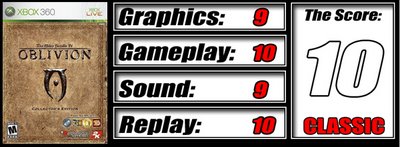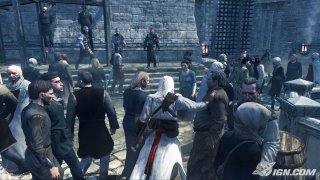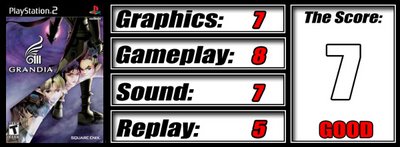
There’s something funny going on in a sleepy little Midwestern town, and photojournalist Frank West (who’s covered wars ya know) is out to get to the bottom of it, or at least snap a couple of hundred photos and earn some good ole fortune and glory by selling the story. Unfortunately for Frank, his ride just dumped him on the roof of a shopping complex that’s filled to the brim with bloodthirsty zombies! Armed with a camera, and whatever he can get his mitts on in the various stores throughout the mall, Frank has to get to the bottom of what’s going on, and maybe save a few survivors, and photograph some carnage in the process.
There you have the setup for Capcom’s first “next gen” offering, Dead Rising. Rather than dip into the Resident Evil well yet-again, Capcom has gone back to their Romero soaked roots to deliver an obvious homage to Romero’s own seminal zombie classic, Dawn of the Dead. The game does a fantastic job of throwing you into the setting with a fantastic intro sequence where you fly over the town taking snapshots of some action before you actually touch down on the mall. Once you get there, you’re dumped unceremoniously on the roof and given a 72 hour time limit to get in, kill some zombies, and find out what the hell is going on. You venture through several sections of the complex, including an outdoor courtyard, food court, and several blocks of stores. Along the way you’ll meet several survivors, whom you’ll have to lead back to the mall’s security room (which is usually pretty infuriating – more on that below) and psychopaths whom you’ll have to put down in some pretty inventive boss battles.
Variety is definitely a plus. As you wind through the various areas of the Willamette Mall you’ll find hundreds of weapon choices, from golf clubs and bowling balls, to chainsaws, lawnmowers, shopping carts, and even CD’s! (Batman soundtrack? Throw it!). There are a ton of outfits available, with a ton more available for free in the xbox live marketplace, there are books and magazines you can read for stat boosts and new special moves, blenders you can use to make all sorts of tasty (or not so much so) drinks which can heal or help you in other ways (pie plus orange juice equals temporary invincibility!) and there are hundreds of photo opportunities you can track down which work towards “leveling up” your character in RPG-like fashion. There’s no shortage of things to do, and part of the fun is experimenting with how specific weapons dice through the hundreds of zombies you run into, or how useless they are. The game unfolds in a decidedly tongue-in-cheek style to a point, and bashing zombies generally doesn’t get old – thanks to Capcom inserting some great boss battles in the form of less than mentally stable survivors called “psychopaths”. Some of these battles become marathons, and they all have a specific pattern or weakness to be exploited if you’re clever enough to figure it out. Some fine examples include a group of escaped convicts racing around the courtyard in a military Hummer (which you can hijack in true GTA fashion), or the family of aspiring snipers, or perhaps the loopy grocery store manager and his shopping cart full of pointy objects. The game breaks things up into two main modes, the 72 hour mode, which will probably take you in the neighborhood of 5-10 hours, and the overtime mode, which is a tad shorter. While both modes do remain pretty engaging, there are a few choices made with regards to the storytelling that baffle. One, plot points unfold based on the game’s internal clock, and if you aren’t in the right place at the right time, you can miss some very important goings on, which pretty much hamstrings the rest of the game and makes for a lousy ending. Two, there’s only ONE save slot – which means when you do screw up and miss something important, you can basically soldier on knowing you’re screwed, or start over (though you’ll keep your powered up character). It’s these decisions that keep the game pretty liner throughout the 72 hour mode, and if you really want the best ending, you’re either going to have to follow a strict walkthrough, play through multiple times, or you’re some kind of gaming prodigy. Luckily the action remains pretty fun throughout without getting monotonous or repetitive, which makes a repeat play through or two an appealing thought. Still, multiple save slots so that you could revert to a few earlier states, and so that someone else logged in under your profile doesn’t accidentally overwrite your own game, would have been nice.
Control-wise, Dead rising handles pretty well. Frank moves a little slowly, which can make some of the faster paced battles, particularly with the psycho bosses, a little difficult. It feels like Frank is walking with a strut or a limp, which doesn’t help much (maybe he twisted his ankle or something when he jumped out of the helicopter… idiot.) Regardless, combat is fast, and pretty accurate without being frustrating or unintuitive. The Camera system could use a little fine tuning, as it’s a little slow to switch from fighting to the camera, snap a nice shot, and then go back to hacking, but it is serviceable and not altogether terrible. Zombie AI, or lack thereof, is convincing enough, and their behavior changes realistically, from passive and stumbling to aggressive when you get close. Human AI on the other hand is lackluster, which makes the survivor escort missions a major pain in the ass. Having to stumble through the mall with a wailing woman or a stupid guy clinging to you, trying to keep them alive while they stop and wait for every clump of zombies to chow down on their collarbones, or get stuck in store counters, is a frustrating experience that drags the game down somewhat. Even when things aren’t so hectic, you’ll find yourself constantly calling out to your follower, and hanging back waiting for them to catch up. It’s frustrating, and drags down an otherwise totally engaging experience. What’s worse is these survivors are essential to getting the better endings in the game. You can arm them with weapons, but it generally doesn’t help much.
Dead Rising is a gorgeous looking affair, with great texture work and some subtle but well implemented effects. Facial features are excellent, animation is smooth and crisp, the varied stores in the mall are much more than flat textured polygons, and everything has a nice three dimensional look. The gore effects are also amazing, with blood spattering over everything, including Frank. The variety of zombies is impressive, with suitably juicy open wounds and decaying flesh, wonderfully textured clothing, and convincing animations. All of Frank’s attacks and special moves look great, from running on the heads and shoulders of a tightly packed group of shambling undead, to caving their skulls in with a 20 pound Sledge Hammer. Everything about the graphics is wholly satisfying. The game does feature some of the trademarked “shadow shimmer” that we saw in a lot of later Xbox games (like Fable) and even many of the current crop (Ghost Recon Advanced Warfighter), which seems to be something that can’t be avoided, but overall the game looks stellar.
In the sound department, the effects are excellent. Each and every kill gives you some wonderfully juicy squish and crunch sounds to accompany the great looking gore. Each and every weapon sounds great. Voice acting is passable, but ultimately typical of your average horror game, hokey and overacted (Frank in particular comes across as a total idiot). Music is your average fluffy light stuff that might accompany a trip to a happy, sunny, mall. It really sets up a pretty entertaining vibe, there’s something surreal about hacking zombies with a katana, or cutting loose with a shotgun, while you listen to a sort of loose interpretation of “The Girl from Ipanema”.
Overall, in spite of some critical missteps with the save system and narrative structure, and perhaps thanks to an absurd batch of characters and an equally absurd plot that fits the game to a tee, Dead Rising does it’s best to become one of the more enjoyable experiences on the Xbox360. It is technically excellent, with a rock solid game engine that stays pretty much bug free and wholly stable throughout the duration. It’s a fluffy and engaging experience that is, on it’s surface, simple and quick to play. Yet it’s RPG elements and the amount of things to do add significant depth. If you’ve ever geeked out to a Zombie picture, or worship at the altar of George R. Romero, then this game is definitely for you. A trip to this mall is almost sure to entertain. There’s plenty of blood and gore spattered about, hence the M-Rating, but in truth, I’d say its fine for Teens as well.









